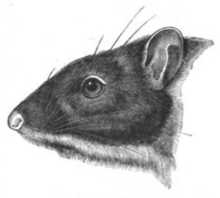
A | B | C | D | E | F | G | H | CH | I | J | K | L | M | N | O | P | Q | R | S | T | U | V | W | X | Y | Z | 0 | 1 | 2 | 3 | 4 | 5 | 6 | 7 | 8 | 9
| Megalomys desmarestii | |
|---|---|

| |
| Stuffed specimen | |
| Scientific classification | |
| Domain: | Eukaryota |
| Kingdom: | Animalia |
| Phylum: | Chordata |
| Class: | Mammalia |
| Order: | Rodentia |
| Family: | Cricetidae |
| Subfamily: | Sigmodontinae |
| Genus: | †Megalomys |
| Species: | †M. desmarestii
|
| Binomial name | |
| †Megalomys desmarestii (J. Fischer, 1829)
| |
Megalomys desmarestii, also known as the Martinique muskrat,[2] Desmarest's pilorie,[3] or the Martinique giant rice rat,[1] is an extinct rice rat from Martinique in the Caribbean.
Description
It was among the largest species of West Indian rice rats, as big as a cat, and was one of the first Caribbean mammals to become extinct during the 20th century.[2] It may have been semi-aquatic, as it was known to escape into the sea when pursued by predators, but it never swam away from the island.[4]

Extinction
It was common on Martinique until the end of the 19th century, when attempts were made to exterminate it because it was considered to be a pest of the island's coconut plantations. It was also hunted for food; however, due to its strong musky odor, this was uncommon. On 8 May 1902, the volcano Mount Pelée erupted, completely destroying the island's principal city of Saint-Pierre. It has been speculated that the rice rat became extinct then or during a later eruption in 1902, but predation by introduced small Indian mongooses is more likely to have been the primary cause of its extinction.[1]
References
- ^ a b c Turvey, S.T.; Helgen, K. (2017). "Megalomys desmarestii". IUCN Red List of Threatened Species. 2017: e.T12980A22377057. doi:10.2305/IUCN.UK.2017-3.RLTS.T12980A22377057.en. Retrieved 18 November 2021.
- ^ a b Watts, David. 1990. The West Indies: Patterns of Development, Culture, and Environmental Change Since 1492. Cambridge University Press ISBN 0-521-38651-9
- ^ Musser, G.G. and Carleton, M.D. 2005. Superfamily Muroidea. Pp. 894–1531 in Wilson, D.E. and Reeder, D.M. (eds.). Mammal Species of the World: a taxonomic and geographic reference. 3rd ed. Baltimore: The Johns Hopkins University Press, 2 vols., 2142 pp. ISBN 978-0-8018-8221-0
- ^ Flannery, T. and Schouten, P. 2001. A Gap in Nature: Discovering the World's Extinct Animals. Atlantic Monthly Press, New York. ISBN 0-87113-797-6
Text je dostupný za podmienok Creative Commons Attribution/Share-Alike License 3.0 Unported; prípadne za ďalších podmienok. Podrobnejšie informácie nájdete na stránke Podmienky použitia.
Antropológia
Aplikované vedy
Bibliometria
Dejiny vedy
Encyklopédie
Filozofia vedy
Forenzné vedy
Humanitné vedy
Knižničná veda
Kryogenika
Kryptológia
Kulturológia
Literárna veda
Medzidisciplinárne oblasti
Metódy kvantitatívnej analýzy
Metavedy
Metodika
Text je dostupný za podmienok Creative
Commons Attribution/Share-Alike License 3.0 Unported; prípadne za ďalších
podmienok.
Podrobnejšie informácie nájdete na stránke Podmienky
použitia.
www.astronomia.sk | www.biologia.sk | www.botanika.sk | www.dejiny.sk | www.economy.sk | www.elektrotechnika.sk | www.estetika.sk | www.farmakologia.sk | www.filozofia.sk | Fyzika | www.futurologia.sk | www.genetika.sk | www.chemia.sk | www.lingvistika.sk | www.politologia.sk | www.psychologia.sk | www.sexuologia.sk | www.sociologia.sk | www.veda.sk I www.zoologia.sk

